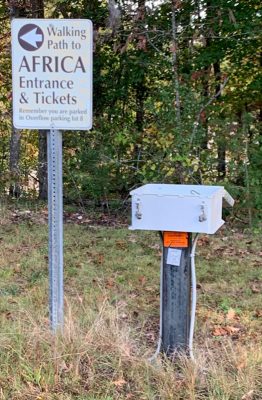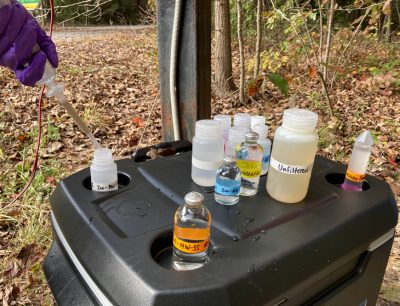It’s a Learning Process: Practicing well water sampling methods in the field
Hannah Peel, NC State, Department of Crops and Soil Science
Graduate trainee, UNC SRP Project 4
There are times when everything goes exactly to plan. There are times when expected challenges crop up. And then there was our first trip to the North Carolina Zoo in Asheboro, NC to learn groundwater sampling techniques.

A groundwater monitoring well at the North Carolina Zoo in Asheboro, NC.
Our group consisted of a lab tech from the University of North Carolina at Charlotte and two PhD students, one from the University of North Carolina at Chapel Hill and one from North Carolina State University. The principal investigator David Vinson, PhD, also from UNC Charlotte, taught us a standard method of sampling well water from pre-existing monitoring wells. We did not realize as our field work began just what a long and illuminating day we were in for!
We arrived early in separate vehicles, a concession to the COVID-19 restrictions that had also kept us from coordinating supplies and materials in-person prior to our outing. It was the first taste of how field work was different from laboratory analysis, which was more familiar than others. Working in a lab typically means that chemicals, glassware and instruments are easily available, but field work requires detailed planning to ensure everything gets from the lab and out to the field. Our field site was on the grounds of the North Carolina Zoo, on a nondescript gravel side road that ran past the groundwater monitoring wells .
Our day began by taking stock of the supplies and instructions, leading to a phone call back to one of the project leads when we realized we hadn’t brought a sample preservation solution, or a way to safely handle the strong acids we needed to use. Some quick rearranging and a new plan to preserve the samples immediately after returning to the lab that afternoon put us back on track to begin setting up our groundwater apparatus.
We replaced the level meter with the pump and allowed it to run until we had emptied the well of roughly three times the volume of water that was sitting stagnant, the standard procedure to purge the well of water that would be heavily impacted by exposure to air in the well. However, our first well was slower to refill than we expected, and we inadvertently pumped it dry. Because the well was slow to refill and the water would be muddy from the fine yellow sand kicked up by the pump, we would not be able to sample from it until the afternoon, we moved onto our second well for the day. Initial set up on the second well went smoothly, right up until one of our pumps began starting and stopping unexpectedly, delaying our sampling preparations.
With an early lunch being our best option, we used that time to talk through how we would take samples.
While it was clear it would be a three-person job, with someone to hold the hose steady and two more to collect samples and preserve them, we knew we would be jostling for space because our only flat area to lay out samples and preservation solutions was the top of our small cooler.

Sampling bottles for collecting groundwater from a monitoring well.
Collecting our first samples from our freshly pumped well was a slow job as we reached over and ran around one another trying to sample the water pouring out of the filter stuck on the end of our pump hose. Eventually, everything was filled, capped and stowed on ice for the trip back to the laboratory, where the samples would be analyzed for metals and other groundwater properties.
By the end of the afternoon, our first well had refilled just enough for us to attempt sampling again, and all of our earlier planning and practice finally came together. We now knew to switch to the slower pump to take our measurements and sample water, without draining the well again. We could arrange the samples in order that facilitated quick collection and preservation without our tripping over each other. Within minutes, we were able to end the day with two complete sets of samples, carefully packed away on ice to be driven back to the lab in Chapel Hill for analysis.
Having the chance to regroup after we’d finished packing up the vehicles was important to reflect on what ended up being a fairly chaotic though successful day of groundwater sampling. First and foremost, we realized preparation would be key for any future sampling events. Communicating with your team, organizing the supplies and physically getting them to the field site is a vital part of making sure the sampling goes smoothly, especially when the team is spread out across the state.
In our case, sampling went quickly and efficiently by the end of the day because we learned to divide the tasks among ourselves and set up our workspace based on the conditions at the wells. Above all, we were glad to have the opportunity to practice these techniques, and to experience all the work that goes into making a sampling event possible. We will certainly be better prepared for whatever issues we encounter the next time!
